Guide to GST Compliance Review
by Madhukar HiregangeCONTENTS
| Preface | iii |
| About the Author | v |
| Table of Cases | vi |
| Chapter 1: Introduction to GST - Compliance Review | |
| 1.1 Introduction to Compliance Reviews | 1 |
| 1.2 Legislative Background of Audit in India | 2 |
| 1.3 Meaning of Audit in GST | 3 |
| 1.4 Importance of Compliance Review | 3 |
| 1.5 Advantages of Compliance Reviews | 4 |
|
4 |
|
5 |
|
6 |
| Chapter 2: Basic Concepts of GST Law | |
| 2.1 Background | 8 |
| 2.2 Scheme of GST | 10 |
|
10 |
|
11 |
|
11 |
|
12 |
|
12 |
|
12 |
|
14 |
|
14 |
|
15 |
|
16 |
|
16 |
|
17 |
|
18 |
|
18 |
|
19 |
|
19 |
|
20 |
|
20 |
|
|
|
22 |
|
23 |
|
24 |
|
25 |
|
26 |
|
26 |
|
28 |
|
30 |
|
31 |
|
32 |
|
32 |
|
33 |
|
34 |
|
34 |
|
35 |
|
36 |
|
37 |
| 2.3 State-Wise Threshold Limits for Obtaining Registration for Different Category of Suppliers Making Supply in Such States | 37 |
| Chapter 3: Professional Opportunities in GST | |
| 3.1 Background | 39 |
| 3.2 Professional's Advantage | 41 |
| 3.3 Professional's Role | 42 |
| 3.4 Types of Services | 46 |
|
46 |
|
47 |
|
48 |
|
49 |
|
49 |
|
50 |
|
51 |
|
51 |
|
52 |
|
53 |
|
54 |
| 3.5 Conclusion | 54 |
| Chapter 4: Relationship between Periodical Returns, Annual Returns and GST Reconciliation Statement | |
| 4.1 Introduction | 55 |
| 4.2 Relationship Between Periodical Returns (GSTR-9 & 9B) And Reconciliation Statement (GSTR-9C) | 55 |
|
56 |
|
56 |
|
57 |
|
58 |
|
59 |
| Chapter 5: Types of Audit and Reviews under GST | |
| 5.1 Introduction | 61 |
| 5.2 Audit By Department - Section 65 of the CGST/SGST Act | 62 |
| 5.3 Key Features of GST Audit by Department | 63 |
| 5.4 Special Audit - Section 66 of the CGST/SGST Act | 64 |
| 5.5 Procedure of Ordering Special Audit and Submission of Special Audit Report | 66 |
| 5.6 Preventive Management Reviews | 66 |
| 5.7 Area-Specific Reviews | 68 |
|
68 |
|
68 |
|
69 |
|
69 |
|
71 |
|
71 |
| Chapter 6: Review Process, Methodology and Approach in GSTR-9C Support | |
| 6.1 Introduction | 72 |
| 6.2 Methodology and Process for Conduct of Health Check Review | 72 |
| 6.3 Stage 1: Preliminary Discussion with Management | 72 |
|
73 |
| 6.4 Stage 2: Obtaining Information from the Client | 75 |
|
76 |
| 6.5 Stage 3: Desk Review | 77 |
|
77 |
|
78 |
| 6.6 Stage 4: Assessment of Risks | 79 |
|
79 |
|
79 |
|
80 |
|
81 |
|
82 |
|
83 |
|
83 |
|
83 |
|
83 |
|
83 |
|
84 |
| 6.7 Stage 5: Review Plan and Review Program | 84 |
|
84 |
|
85 |
|
85 |
|
85 |
| 6.8 Stage 6: Work at the Office of Client | 86 |
|
87 |
|
87 |
|
88 |
|
88 |
|
89 |
| 6.9 Stage 7: Tools and Techniques for Conducting a Review | 89 |
|
89 |
|
89 |
|
90 |
|
90 |
|
90 |
|
93 |
|
93 |
|
95 |
|
95 |
|
96 |
|
96 |
| 6.10 Stage 8: Review Documentation and Working Papers | 96 |
|
97 |
|
97 |
|
97 |
|
98 |
| 6.11 Stage 9: Draft Report and Obtaining Management Comments | 98 |
|
98 |
|
99 |
| 6.12 Stage 10: Preparation of Final Review Report | 100 |
| Chapter 7: Internal Controls | |
| 7.1 Introduction | 101 |
| 7.2 Standard on Internal Audit | 101 |
| 7.3 GST Internal Control Questionnaire (ICQ) | 103 |
|
103 |
|
103 |
|
104 |
|
104 |
|
105 |
|
106 |
|
106 |
|
106 |
|
107 |
|
107 |
|
107 |
|
108 |
|
108 |
|
108 |
|
109 |
|
109 |
|
111 |
|
111 |
|
112 |
|
113 |
|
113 |
|
115 |
|
115 |
|
116 |
|
117 |
|
118 |
|
118 |
|
118 |
|
119 |
|
119 |
|
120 |
|
120 |
|
120 |
|
121 |
|
121 |
|
121 |
|
122 |
|
123 |
|
123 |
|
123 |
| 7.4 Customs Related Internal Control Questionnaire | 124 |
|
124 |
|
124 |
|
124 |
|
125 |
|
125 |
|
126 |
| Chapter 8: Accounts, Records and Documents to be Maintained | |
| 8.1 Introduction | 127 |
| 8.2 Verification of Accounts and Records in Audit | 127 |
|
128 |
| 8.3 Various Accounts, Records and Documents to be Maintained | 129 |
|
129 |
|
131 |
|
132 |
|
133 |
|
134 |
| 8.4 Contravention of the above Requirement to Maintain Accounts, Records and Documents | 134 |
| 8.5 Checklist of Various Accounts, Records and Documents to be Verified while Compliance Review | 135 |
| 8.6 Key Checkpoints for Auditor in Various Accounts and Records Maintained | 136 |
|
136 |
|
137 |
|
139 |
|
139 |
| 8.7 Recommended Formats of Sales Register, ITC Register and RCM Register | 140 |
| Chapter 9: Outward Supply | |
| 9.1 Introduction | 142 |
| 9.2 Verification of Financial Statements | 142 |
|
142 |
|
143 |
|
143 |
|
144 |
|
144 |
|
145 |
|
146 |
|
146 |
|
147 |
|
147 |
|
148 |
|
150 |
|
153 |
|
155 |
|
156 |
|
157 |
|
157 |
|
158 |
|
159 |
|
160 |
|
161 |
|
161 |
|
162 |
|
163 |
|
164 |
| Chapter 10: Inward Supply - ITC | |
| 10.1 Eligibility and Conditions for Availing Input Tax Credit | 165 |
|
165 |
|
166 |
|
167 |
|
167 |
|
167 |
|
167 |
|
168 |
|
168 |
| 10.2 Manner of Utilizing Input Tax Credit | 169 |
| 10.3 Apportionment and Reversal of Input Tax Credit [Section 17 Read with Rules 42 & 43] | 169 |
|
169 |
|
170 |
|
170 |
|
171 |
|
171 |
| 10.4 Blocked Credits | 171 |
| 10.5 Availability of Credit in Special Circumstances [Section 18] | 176 |
|
176 |
|
176 |
|
176 |
|
176 |
| 10.6 Transfer of Credit on Obtaining Separate Registration for Multiple Places of Business [Section 25(2) Read with Rule 41A] | 177 |
| 10.7 Manner of Claiming Credit [Rule 40]. | 177 |
|
177 |
|
177 |
|
177 |
|
178 |
|
178 |
| 10.8 Transfer of Input Tax Credit in Case of Change in Constitution of Business [Section 18(3) R/W Rule 41]. | 178 |
|
178 |
|
178 |
|
179 |
|
179 |
| 10.9 Payment of Input Tax Credit in Case Regular Taxpayer Switching to Composition Scheme or Supplies Become wholly Exempt [Section 18(4) R/W Rule 44] | 179 |
|
179 |
| 10.10 Payment of Input Tax Credit on Supply of Capital Goods [Section 18(6)] | 180 |
|
180 |
|
180 |
|
181 |
| 10.11 Input Tax Credit in Respect of Inputs and Capital Goods Sent for Job-Work [Section 19 Read with Section 143 and Rule 45] | 181 |
|
182 |
| 10.12 Credit by Input Service Distributor | 182 |
|
182 |
|
183 |
|
183 |
|
185 |
| 10.13 Reversal of ITC on Non-Payment by Supplier [Rule 37A]. | 185 |
| 10.14 Electronic Credit Reversal and Reclaimed Statement (ECRRS). | 186 |
| 10.15 RCM Liability/ITC Statement | 186 |
| 10.16 Invoice Management System (IMS) | 186 |
| 10.17 Manner of Dealing with Doubtful ITC | 187 |
| 10.18 ITC Review Checkpoints | 188 |
| 10.19 ITC-Inputs/Input Services | 188 |
| 10.20 ITC - Capital Goods | 191 |
| 10.21 Input Service Distribution | 192 |
| 10.22 Imports of Goods / Services | 193 |
| 10.23 Employee Expenses | 194 |
| 10.24 Bank Statement | 195 |
| 10.25 Reconciliation | 195 |
| 10.26 Ratios and Management Information System (Mis) | 196 |
| Chapter 11: Reverse Charge | |
| 11.1 Introduction | 197 |
| 11.2 Forward Charge vs Reverse Charge | 197 |
| 11.3 Levy vs Liability | 198 |
| 11.4 Statutory Provisions | 198 |
| 11.5 Reverse Charge on Supply of Goods | 199 |
| 11.6 Reverse Charge on Supply of Services | 199 |
|
202 |
|
202 |
|
203 |
|
203 |
|
204 |
|
205 |
|
205 |
|
206 |
|
206 |
|
206 |
| 11.7 Documents to be Issued | 207 |
|
207 |
|
207 |
| 11.8 Disclosure in the Returns | 207 |
| 11.9 Delayed Payment of Reverse Charge Liability and ITC Eligibility | 208 |
| 11.10 Relevant Judicial Pronouncements | 208 |
|
208 |
|
209 |
|
209 |
|
209 |
|
209 |
|
209 |
|
210 |
|
210 |
|
210 |
|
210 |
| 11.11 Verification of Reverse Charge Mechanism | 210 |
| Chapter 12: Refunds | |
| 12.1 Introduction | 212 |
| 12.2 Types of Refund | 212 |
|
212 |
|
212 |
|
213 |
|
213 |
| 12.3 Verification of Refund During Review | 213 |
| Chapter 13: Procedural Aspects | |
| 13.1 Registration Under GST | 216 |
|
216 |
|
216 |
| 13.2 Returns Under GST | 218 |
|
218 |
|
221 |
|
223 |
|
223 |
|
224 |
|
224 |
|
224 |
|
224 |
|
225 |
|
225 |
|
225 |
| 13.3 Records Under GST | 226 |
|
226 |
|
229 |
|
229 |
|
230 |
|
231 |
| 13.4 Documentation Under GST | 231 |
|
231 |
|
232 |
|
236 |
|
237 |
| 13.5 Payment Under GST | 239 |
|
239 |
| 13.6 Payment Under Protest in GST Regime | 240 |
| Chapter 14: Reconciliations | |
| 14.1 Introduction | 243 |
| 14.2 Reconciliation of Supply (after Considering the Returns) on which Output Tax is Payable | 244 |
|
246 |
|
247 |
|
247 |
| 14.3 Reconciliation between GSTR-1 to GSTR-3B | 247 |
| 14.4 Identification of Disclosure Errors between GSTR-3B and GSTR -1 for Normal Registered Person (other than Person Registered as SEZ) | 250 |
|
250 |
|
251 |
| 14.5 ITC Review - GST | 251 |
|
253 |
|
256 |
| 14.6 Reconciliation of Expenses on which ITC is Available | 259 |
| 14.7 Reconciliation of ITC | 261 |
|
264 |
|
264 |
|
265 |
| 14.8 Reconciliation Between GSTR-2B and Books of Account | 265 |
| 14.9 Identification and Reverse Charge Reconciliation | 267 |
|
271 |
|
271 |
|
272 |
|
272 |
|
273 |
|
273 |
| 14.10 Job Work Reconciliation | 274 |
| 14.11 E-Way Bill Reconciliation | 275 |
| 14.12 E-Invoicing Reconciliation | 277 |
| 14.13 Exports Reconciliation | 278 |
|
278 |
|
278 |
|
278 |
|
279 |
|
279 |
| 14.14 Reconciliation with Scrip's Obtained under Foreign Trade Policy | 279. |
| 14.15 Refunds Reconciliation | 279 |
| 14.16 Reconciliation with Electronic Credit/ Liability Ledger | 280 |
| 14.17 Reconciliation with the Shipping Bill Data | 280 |
| 14.18 Other Reconciliations | 281 |
| Chapter 15: Common Errors to be Avoided in GST | |
| 15.1 Introduction | 283 |
| 15.2 Conceptual Errors | 283 |
| 15.3 System Errors | 290 |
| 15.4 Compliance Errors | 294 |
| 15.5 Errors in GST Annual Return | 295 |
| Chapter 16: Important Year End Action Points in GST | |
| 16.1 Introduction | 298 |
| 16.2 Cross Charge to Related/Distinct Persons & ISD | 298 |
| 16.3 Review of ITC Ledger and Vendor Invoices | 299 |
| 16.4 E-Way Bill Compliance and Reconciliation | 300 |
| 16.5 ITC Reversal and Year-End Adjustments | 301 |
| 16.6 Reconciliation | 302 |
| 16.7 GST Payment Under Reverse Charge | 302 |
| 16.8 Issue of Debit/Credit Note | 302 |
| 16.9 Return Filing for the Month of October | 303 |
| 16.10 Track of Goods Sent for Job Work | 305 |
| 16.11 GST Payment by Builders/Promoters under Reverse Charge Mechanism for Shortfall from 80% | 305 |
| 16.12 Other Aspects | 305 |
| Chapter 17: Sample Review Report | |
| 17.1 Introduction | 308 |
| 17.2 Different Heads of Report | 308 |
|
308 |
|
308 |
|
308 |
|
308 |
|
308 |
|
309 |
|
309 |
| 17.3 Sample GST Compliance Review Report Template | 309 |
| Chapter 18: Customs Audit | |
| 18.1 Introduction | 316 |
|
316 |
|
317 |
|
318 |
|
319 |
|
319 |
| 18.2 Customs Review Programme | 320 |
|
321 |
|
329 |
|
330 |
| Chapter 19: Certifications under GST | |
| 19.1 Introduction | 332 |
| 19.2 Authenticity and Reliability of the Certificates Issued by the Professionals | 333 |
| 19.3 Certification of the ITC Claimed Under Special Circumstances | 335 |
| 19.4 Certification on Transfer of Credit on Sale, Merger, Amalgamation, Lease or Transfer of a Business (Rule 41(2)) | 337 |
| 19.5 Certification on Reversal of Credit Under Special Circumstances (Section 18(4) read with Rule 44) | 337 |
| 19.6 Application for Refund of Tax, Interest, Penalty, Fees or any other Amount (Rule 89(2)) | 339 |
| 19.7 Certification for Claiming of Reimbursement of Tax Paid Under 'Seva Bhoj Yojana' (C.B.I. & C. Circular No. 75/49/2018-GST, Dated 27-12-2018) | 340 |
| 19.8 Certification in Case of Mismatch of ITC Between GSTR-3B and GSTR-2A | 341 |
| 19.9 Certification to Claim GST Deduction Towards Credit notes Issued to Recipients | 344 |
| Chapter 20: Departmental Audit | |
| 20.1 Introduction | 346 |
| 20.2 Statutory Powers and Obligations | 347 |
|
347 |
|
348 |
| 20.3 Preparations for Audit | 348 |
| 20.4 Tips to Taxpayers/Professionals before, During and follow up of ahe Audit | 350 |
| Chapter 21: Important Judgements Relevant for GST | |
| 21.1 Introduction | 353 |
| 21.2 General | 353 |
|
353 |
|
353 |
|
354 |
| 21.3 Levy of GST | 354 |
|
354 |
|
354 |
|
354 |
|
355 |
|
355 |
|
355 |
|
356 |
|
356 |
|
356 |
|
356 |
|
357 |
|
357 |
|
357 |
|
358 |
|
358 |
|
358 |
|
358 |
|
358 |
| 21.4 Valuation | 359 |
|
359 |
|
359 |
|
359 |
|
360 |
| 21.5 Place of Supply | 360 |
|
360 |
|
360 |
| 21.6 Input Tax Credit | 361 |
|
361 |
|
361 |
|
361 |
|
361 |
|
361 |
|
362 |
|
362 |
|
368 |
| 21.7 Procedure Related Judgements | 363 |
|
363 |
|
363 |
|
363 |
|
363 |
|
364 |
|
364 |
| 21.8 Royalty is not in the Nature of Tax | 364 |
| 21.9 Ambulance Service Cannot be Called as Rent-A-Cab Service | 364 |
| 21.10 Aspect Theory | 365 |
| 21.11 Parallel Proceedings (Principles of Comity) | 365 |
| Chapter 22: Introduction to Annual Returns | |
| 22.1 Introduction | 366 |
| 22.2 Persons Required to File Annual Return | 368 |
| 22.3 Manner of Filing the Annual Return | 369 |
| 22.4 Impact of Annual Return on Reconciliation Statement | 370 |
| 22.5 Consequences of non-Compliance | 371 |
| 22.6 Revision of Annual Return | 371 |
| Chapter 23: Role of Assessees and Professionals in filing Annual Return | |
| 23.1 Role of Assessee in Filing the Annual Return | 372 |
| 23.2 Role of Professionals in Filing Annual Return | 374 |
| Chapter 24: Good Accounting Practices for ease in Preparation & Filing of Annual Returns and Reconciliation Statement | |
| 24.1 Introduction | 376 |
|
376 |
|
377 |
|
378 |
|
378 |
|
379 |
|
379 |
| 24.2 Good Accounting Practices for Recording of the GST Transactions | 379 |
| 24.3 Performance of Key Reconciliations at Periodic Intervals. | 380 |
| 24.4 Tax Efficient Accounting | 381 |
| Chapter 25: Clause by Clause Analysis of Annual Return - Form GSTR-9 | |
| 25.1 Source Data for Filing Annual Return | 387 |
| 25.2 Basic Steps before Filling Annual Return for Filing | 387 |
| 25.3 Broad Structure of Annual Return | 391 |
| 25.4 Details Required in the Annual Return | 394 |
| 25.5 Clause by Clause Analysis of GSTR-9 Form | 394 |
| 25.6 Details not Required to be Furnished in the Annual Return | 459 |
| Chapter 26: Clause by Clause Analysis of Annual Return - Form GSTR-4 | |
| 26.1 Details Required In The Annual Return | 461 |
| Chapter 27: Annual Return - Form GSTR-9B | 464 |
| Chapter 28: Steps in Filing of Annual Returns on GST Common Portal | |
| 28.1 Steps in Filing the Annual Return Directly on Portal | 465 |
|
465 |
|
466 |
|
467 |
|
467 |
|
467 |
|
468 |
| 28.2 Introduction to Excel Based GSTR-9 Offline Tool | 468 |
|
469 |
|
469 |
| Chapter 29: Important Tips and Formats for Preparation of Annual Return | |
| 29.1 Some Common Checkpoints within GSTR-9 | 471 |
| 29.2 Important Formats | 474 |
| Chapter 30: Checklist for Annual Returns for Professionals | 478 |
| Chapter 31: Practical FAQ's in Filing of Annual Returns | |
| 31.1 FAQS on Basics in Annual Return | 484 |
| 31.2 FAQS on Disclosure of Outward Supplies in Annual Return | 487 |
| 31.3 FAQS on Outward Supplies | 488 |
| 31.4 FAQS on Input Tax Credits | 499 |
| 31.5 Other Miscellaneous FAQS | 508 |
| Chapter 32: Role of Client and Reviewer in GST Review & Self-Certification | |
| 32.1 Introduction | 513 |
| 32.2 Role of the Client in GST Review | 513 |
| 32.3 Role of Professionals in a Review Engagement | 513 |
|
|
| Chapter 33: Clause by Clause Analysis of GSTR-9C | |
| 33.1 Introduction | 515 |
| 33.2 Need for Reconciliation | 515 |
| 33.3 Structure of Reconciliation Statement in Form GSTR-9C | 516 |
| 33.4 Detailed Step by Step Understanding of Form GSTR-9C | 518 |
|
518 |
|
522 |
|
598 |
|
616 |
| Chapter 34: Steps In Filing of GSTR-9C On GST Common Portal | |
| 34.1 Introduction | 620 |
| 34.2 Filing of GSTR-9C on GST Portal | 620 |
| 34.3 Procedure for Filing GSTR-9C | 620 |
| Chapter 35: Documentation and Work Papers in GST Review - Best Practices | |
| 35.1 Introduction | 642 |
| 35.2 Purpose of Review Documentation | 642 |
| 35.3 Form & Contents of Documentation | 643 |
|
643 |
|
645 |
|
648 |
| 35.4 Contents of Review Working Papers | 652 |
| 35.5 Documentation in an A-I Environment | 652 |
| 35.6 Ownership of Review Documentation | 655 |
| 35.7 Points to be Noted for Effective Documentation | 655 |
| Chapter 36: Review Program and Checklist on GST Review for use by Professionals | |
| 36.1 Introduction | 657 |
| 36.2 Sample Review Program | 657 |
| 36.3 Checklist for Conducting GST Review | 659 |
| Chapter 37: Ethical Standards and Independence of Auditor | |
| 37.1 Introduction | 667 |
| 37.2 Fundamental Principles | 667 |
| 37.3 Identification and Evaluation of Various Threats | 668 |
| 37.4 Conflict of Interest | 669 |
| 37.5 Other Factors which could Pose Threat | 670 |
| 37.6 Independence of the Auditor | 671 |
| 37.7 Tax Services to GST Review Clients | 672 |
| 37.8 Impact of Other Provisions | 674 |
| 37.9 Ensuring Independence in an AI Environment | 674 |
| 37.10 Important Case Studies on Professional Misconduct | 676 |
| Annexure 1 - FAQs On Ethical issue relating to GST - Announcement 15.11.20171 | 682 |
| Appendices | 684 |
| Appendix 1: Annual Returns in Form GSTR-9 and GSTR-4 | 685 |
| Appendix 2: Reconciliation Statement and Certification in Form 9C | 706 |
| Appendix 3: Abstract of Provisions of Annual Return under Goods and Services Tax Act, 2017 | 719 |
| Appendix 4: Procedure of Audit in GST Rules, 2017 | 720 |
| Appendix 5: Accounting Entries of GST | 721 |
| Appendix 6: Audit Report under the Companies (Auditor's Report) Order, 2016 in relation to Indirect Taxes | 727 |
| Appendix 7: Engagement and Quality Control Standards of ICAI | 728 |
| Appendix 8: List of Important Publications of the Institute of Chartered Accountants of India, ICAI, New Delhi | 729 |
| Appendix 9: Statutory Provisions in Customs Law Relating to Customs Audit | 731 |
| Bibliography/Webliography/References 735 |
About the Author
Have Questions About This Book?
Our course advisors are here to help you make the right decision for your career growth.
Other books
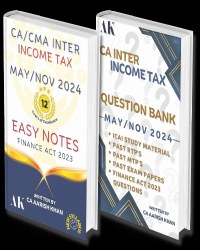
CA/CMA INTER COMBO - COLOURED EASY NOTES + QUESTION BANK
CA Aarish Khan
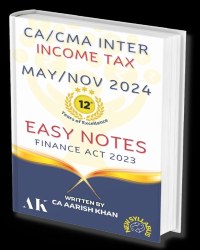
CA/CMA INTER EASY NOTES COLOURED
CA Aarish Khan
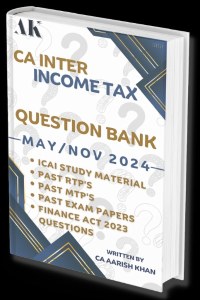
CA/CMA INTER INCOME TAX QUESTION BANK
CA Aarish Khan

GST (IDT) Book - 4th Edition | May, Sept 2026 & Jan 2027 Attempt
CA Arpita Tulsyan
Join Us !!
List your Books
Share your knowledge and help shape the next generation of tech-savvy CA & Tax professionals while building a rewarding career in education.
Get Started

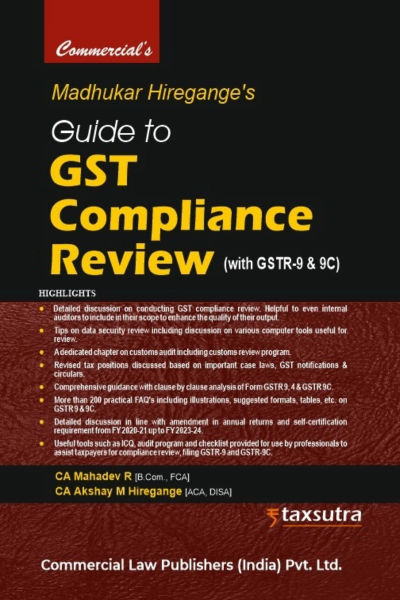
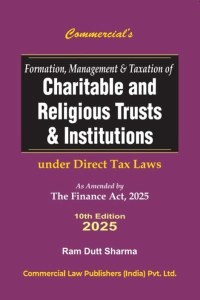
 CAclubindia
CAclubindia
